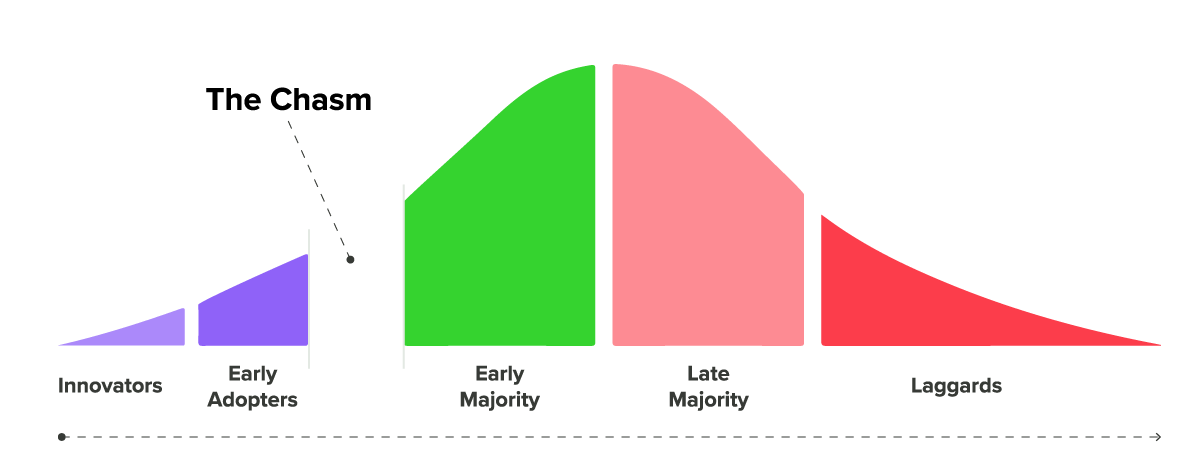What is the Product Adoption Curve?

An essential element of any successful business is a keen understanding of your target customer. The needs and challenges of your ideal customer should inform everything you do as a business, including your product.
For most SaaS businesses, your product is the heart of what you do. That said, even if your product addresses every need and solves every challenge, your ability to establish yourself in the marketplace may not happen as quickly as you’d like.
The product adoption curve can provide helpful insights into how and when to target certain portions of your customer base.
What is the Product Adoption Curve?
The product adoption curve is a visual representation of the way different groups of people have a willingness to try out your product over time.

The curve and its respective phases don’t indicate who you should sell your product to, but rather about how and when you target segments of your ideal customers. Across your customer base, there are those who will purchase on the early side and those on the later side.
The product adoption curve is broken down into five phases: innovators, early adopters, early majority, late majority and laggards. Each of these phases has its own distinct advantages and challenges you will need to address to ensure market saturation.
Incorporating messaging and marketing tactics for each of these phases is an important aspect of crafting your go-to-market strategy.
Phases of the Product Adoption Curve
Innovators
These are the first people who will purchase your product. Generally defined as tech enthusiasts, customers in this phase are open to risk and eager to try new things.
One of the greatest advantages of innovators is they are an excellent source of feedback and advice regarding the development of your product. They’re not especially concerned about your product’s general use-case as they’re more interested in trying the latest technology.
The benefit here is that your product doesn’t need to be a fully realized masterpiece. Instead, you can lean on advice and feedback from these very early customers to make adjustments and improvements as you achieve greater market penetration.
A disadvantage when dealing with innovators is that they’re generally not willing to spend a lot of money on your product. To solicit the necessary feedback for your product’s long-term growth, you may need to sacrifice revenue with a discounted or freemium model at this stage.
Early adopters
The next and slightly larger portion of customers are your early adopters. Unlike innovators, early adopters are more aligned with your day-to-day, long-term users. They’re visionaries looking for the answer to their greatest challenges — your product.
As your standard end-user, early adopters can provide fantastic insight into how to position your product in your marketing and sales efforts based on how it solved for their needs.
Early adopters generally want faster time to value and a more customized approach from your product. Addressing large issues brought up during the innovator’s phase is important to meeting the needs of your early adopters.
With that in mind, the greatest advantage of this phase are the case studies you can generate from it. When planning your go-to-market strategy, your product should solve the pain points of these earliest buyers the most.
In doing so, your innovators and early adopters can provide case studies for your product’s success to influence buyers down the line in later stages.
Early majority
Reaching the early majority phase is a clear sign that you have found product-market fit. While you have likely gone through many rapid changes and iterations to reach this point, the early majority offers the largest market size and growth potential.
That said, there is a chasm between early adopters and early majority. Customers in the early majority are pragmatists who want something finalized that solves for their needs.
The best way to reach these customers is to have bonafide case studies and testimonials on the success of your innovators and early adopters. Failing to impress your innovators and early adopters can halt your product’s progress over the chasm.
Late majority
At this point, there is a certain degree of confidence that you should have. The late majority make up a smaller percentage of your customers and are generally conservatives that are either apprehensive to change or less aware of it happening.
The advantage you have with this group is the opportunity for more transactional sales and lower expectations. Your messaging doesn’t need to convince or educate the late majority the same way it may have to convince earlier customers.
In this stage, your messaging isn’t revealing new information. Instead, it should focus on overcoming the late majority’s preconceived notions that have prevented them from purchasing sooner.
Laggards
A very small percentage of your customers are laggards. Buyers in this stage are very skeptical of your product and whether it can truly solve for their needs.
While you can hone messaging to challenge their skepticism, there is a certain degree to which you shouldn’t be selling to laggards. If you’ve reached this point, you may be saturating the market or losing out on market share to competing products.
With that in mind, reaching the laggard stage means it’s time to re-evaluate your product, consider new innovations or new product offerings to continue to scale your business effectively and sustainably.
Takeaway
The product adoption curve is an important element of your go-to-market strategy. The curve paints a picture of your earliest buyers, ensuring you solve for their greatest needs and challenges as soon as your product launches.
Additionally, it helps you better align your messaging to different segments of your customer base and position your product effectively depending on where you are on the curve.
Chris Singlemann
Chris is a Brand Marketer at New Breed where he is responsible for crafting design and video assets that support our brand. When he's not behind the camera, he enjoys kayaking and tending to his sourdough starter.





